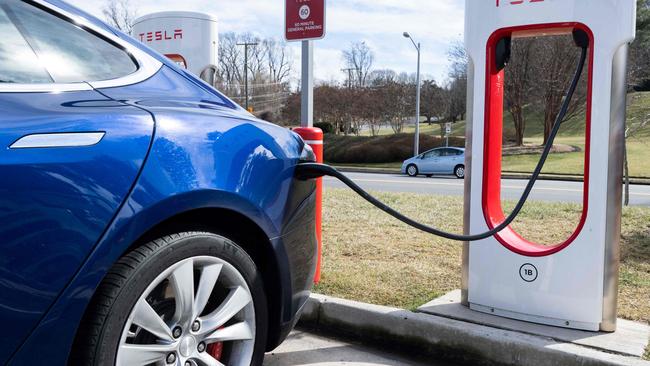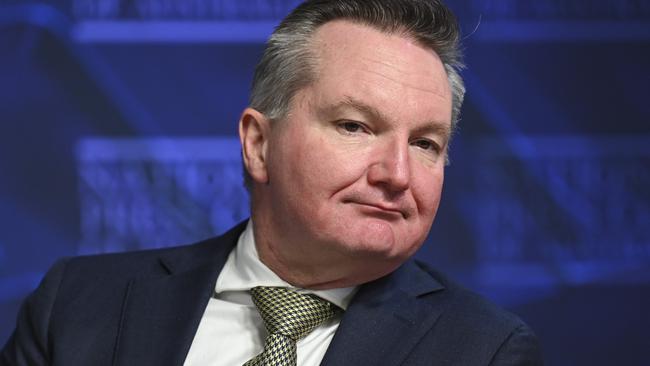States asked to back Chris Bowen’s plan allowing Australians to use EVs to charge homes, support grid
Chris Bowen ruled out subsidising gas if the Albanese government was re-elected, saying it would play an important but pragmatic role under Labor.

Australians would be able to use their electric vehicles to charge their homes and be paid to put their car’s stored energy into the grid, under a proposal Chris Bowen will put to the states.
The Climate Change and Energy Minister said he’d like the plan – which forms part of the government’s consumer energy road map – to be rolled out “over the next year or so”, though conceded that was an ambitious timeline.
As the election battlelines on energy are sharpened, Mr Bowen also ruled out subsidising gas if the Albanese government was re-elected, saying it would play an important but pragmatic role under Labor akin to life insurance.
He dismissed the idea of including gas in the Capacity Investment Scheme because “it wouldn’t win” and couldn’t compete economically with renewables.
His rejection of gas in the CIS came on the same day opposition climate change and energy spokesman Ted O’Brien declared: “We need gas. We need gas. We need gas, we need more of it.”

Mr Bowen will meet with state energy ministers on Friday to put his case for vehicle-to-home and vehicle-to-grid charging, with experts saying EVs could power a house for two to four days.
“It is a resource that we need to harness and enable households to harness in their own best interests,” he told the National Press Club in Canberra. “If you’ve got an electric vehicle and you can decide not only when you’re going to charge it, but you can decide when you’re going to take the power in it to charge your home or charge the grid and get paid for that, that’s empowering consumers.
“There are certain things that we need to deal with. Standards Australia needs to come up with appropriate standards. They are working on that. We have some regulatory processes to go through, the states and I. But … I am hopeful and confident that states will agree with the consumer energy road map and the importance of vehicle-to-grid charging and vehicle-to-home charging. Because cars are batteries on wheels.”
While the proposal has the backing of some energy experts and EV advocates, Australian National University senior research fellow Bjorn Sturmberg noted Australia still required a mass market charger that enabled EVs to discharge energy to the home.
“That could be something that pretty much changes overnight,” said Dr Sturmberg, research leader at the ANU’s Battery Storage and Grid Integration Program.
“The hardware is in place in a lot of standard EVs where they can discharge (energy). Having gone through that process of bringing an internationally manufactured charger into Australia (with discharging capability) ... it was massively painful but we found all the gotchas and so doing that a second time should be more straight forward.”
Peter Dutton lashed Mr Bowen and his “desperate chants” after the minister insisted nuclear energy and renewables were “simply incompatible”, but would not detail how much energy under a future Coalition government would come from renewables.
“The international experts and those that are here, including Dick Smith and Adi Paterson and others, Ziggy (Switkowski), you look at what all of them have had to say – and that is that nuclear is required in the system because, without it, we’re going to have blackouts and the intermittent power. That is the power that’s not 24/7 like wind and solar. It’s going to drive up the price of electricity,” the Opposition Leader said. “If we don’t take action, we are going to see a massive economic disruption, as well as social disruption in our country. That’s not something that I’m going to tolerate.”
Tony Wood, Grattan Institute Energy and Climate Change Program director, said large baseload nuclear power plants couldn’t be used to back up renewables but it could be possible with small-scale modular reactors, which aren’t currently commercially viable.
“The only thing that makes sense is to have something that can turn on and off quickly when there’s no wind and sun,” he said. “It could be small-scale modular reactors, but no one has done that yet. At the moment there’s some very big unfilled holes in the opposition’s policy. They haven’t said how renewables and gas and nuclear would work together.”
Dr Sturmberg said much more could be done to allow EVs to support the grid or load shed.
A study he led during a major storm event in Victoria on February 13 found stopping 60,000 EVs from charging would have kept the power on for 90,000 customers whose power was cut.





To join the conversation, please log in. Don't have an account? Register
Join the conversation, you are commenting as Logout